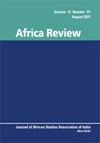颠覆性的地毯或艺术如何与后殖民时期马格里布的苦难和解:阅读莱拉·拉拉米的《讲故事的人》
IF 0.5
Q4 AREA STUDIES
引用次数: 2
摘要
对非法移民的研究很少考察后现代主义的推动力,这种推动力依赖于后殖民主体及其选择。下面这篇文章是关于Laila Lalami的最后一篇作品,题目是《希望与其他危险的追求》(2005)中的“讲故事的人”,这位摩洛哥裔美国作家仔细地追溯了穆拉德从焦虑的渣滓中崛起的过程,并提出了一个论点。这种上升反映了马格里布年轻人的生活,他们寻求非法移民或harr 'ga,作为后现代主义对后殖民经验的冲击的一部分。在穆拉德的情况下,拥抱未来是可能的,通过情感的方式,而不是认知的方式,通过投资文化记忆。在被西班牙驱逐出境后,失败的哈拉格人穆拉德在情感上受到了伤害,一股毁灭的力量推动着他自己的毁灭。只有当他遵守从他已故的父亲那里得知的故事时,他才注意到他与苦难和解的机会。通过古马里(Ghomari)的中世纪故事,穆拉德摆脱了两位美国游客对后殖民意味着什么的情感上的疏忽。古马里是一个编织地毯的人,他的艺术推翻了一个暴君。最终,穆拉德决定成为一名作家:艺术家和梦想家。通过结合现象学、存在主义和神话的见解,这篇文章强调了拉拉米的故事如何引导读者发现马格里布青年的赋权叙事;情感赋权根植于承担责任和模仿神话英雄。本文章由计算机程序翻译,如有差异,请以英文原文为准。
The subversive rug or how art reconciles with suffering in the postcolonial Maghreb: a reading of Laila Lalami’s ‘The Storyteller’
ABSTRACT Research on illegal immigration rarely checks the postmodernist propulsions that hinge on postcolonial subjects and their choices. In the following essay on Laila Lalami’s last piece, titled: ‘The Storyteller’ in Hope and Other Dangerous Pursuits (2005), an argument is specified through the Moroccan-American author carefully tracing Murad’s rise from the dregs of angst. This rise reflects the lives of disenchanted Maghrebi youths seeking illegal immigration or harr’ga as part of impinging postmodernism on postcolonial experience. Embracing the future in Murad’s circumstances could be possible via affective, not cognitive, means, by investing in cultural memory. Following his deportation from Spain, Murad, the failed harr’ag, becomes emotionally damaged, a force of destruction propelling his own annihilation. Only when abiding by the story he learned from his deceased father does he notice his chances of reconciling with suffering. Through the medieval story of Ghomari, the rug weaver, whose art brought down a despot, Murad shakes off the two American tourists’ emotional oversight of what it means to be postcolonial. Eventually, Murad decides to become a writer: an artist and dreamer. By combining phenomenological, existential, and mythical insights, the essay highlights how Lalami’s story leads readers to discover an empowering narrative for the Maghrebi youth; affective empowerment rooted in shouldering responsibility and emulating the mythic hero.
求助全文
通过发布文献求助,成功后即可免费获取论文全文。
去求助
来源期刊

Africa Review
AREA STUDIES-
CiteScore
1.80
自引率
12.50%
发文量
22
期刊介绍:
Africa Review is an interdisciplinary academic journal of the African Studies Association of India (ASA India) and focuses on theoretical, historical, literary and developmental enquiries related to African affairs. The central aim of the journal is to promote a scholarly understanding of developments and change in Africa, publishing both original scholarship on developments in individual countries as well as comparative analyses examining the wider region. The journal serves the full spectrum of social science disciplinary communities, including anthropology, archaeology, history, law, sociology, demography, development studies, economics, education, gender studies, industrial relations, literature, politics and urban studies.
 求助内容:
求助内容: 应助结果提醒方式:
应助结果提醒方式:


